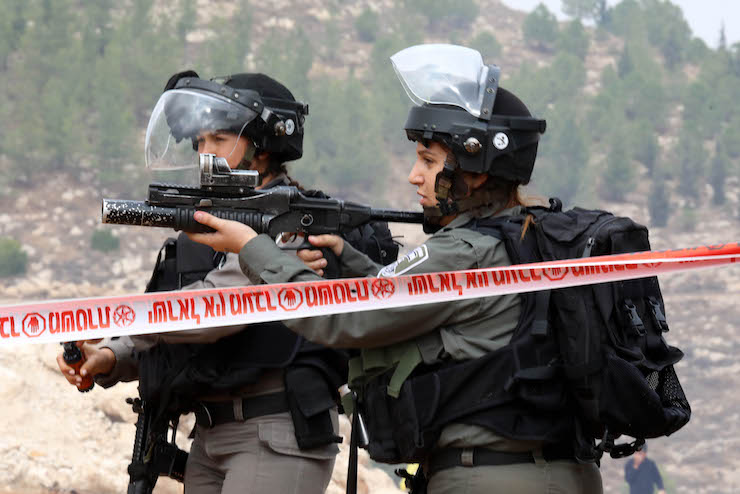
A Palestinian journalist lost his eye after Israel Border Police officers opened fire at demonstrators in a village near Hebron in the occupied West Bank on Friday. The photojournalist, Moath Amarnih, was wounded while covering confrontations between young Palestinian protesters and police following a demonstration against a settlement’s takeover of land belonging to the Palestinian village of Surif, northwest of Hebron.
According to journalists who were at the scene, Border Police officers used live 0.22 inch Ruger rifle bullets (also known as “two-two” bullets) against the demonstrators, which likely struck the leg of one protester before changing direction and hitting Amarnih, who was standing approximately 150 meters from the officers, in the eye. The officers did not offer him medical aid and delayed his evacuation from the scene. One of the officers filmed Amarnih’s face from up close as he was being carried away by journalists.
“I saw him take a live bullet to the head, I thought he was dead,” said one Palestinian journalist who was standing near Amarnih at the moment he was shot.
For the second week in a row, dozens of Palestinians marched in Surif against the fencing off of their agricultural land in order to expand the adjacent settlement. The villagers attempt to reach the fenced-off land and hold a mass prayer there, yet have not been allowed to enter by Border Police officers, who used tear gas and stun grenades to put down the protest.
A few hundred meters from the site of the protest, several young Palestinians began throwing stones at the officers. “There were around seven young men who threw stones and blocked the dirt path,” the journalist said. “We climbed the hill to avoid the line of fire. After 10 minutes, a soldier shot a Ruger bullet that hit a protester. The bullet passed through his leg, changed direction, and hit Moath, who was not standing behind the stone throwers and the police.”
Ruger bullets generally cause less severe wounds than “ordinary” bullets, yet can still be lethal or inflict serious injuries.
“There were around six young people who threw stones at the police after the protest ended,” said Hazem Bader, a photographer for French media agency AFP. “The bullet, or part of it, flew into his eye. The x-ray showed part of the bullet [in his eye.]”
The officers then filmed Amarnih being carried by Bader and another journalist toward a vehicle; none of the officers offered any aid or assistance. “They saw us carrying him, they did not offer any aid. On the contrary, some of the Border Police officers tried to film and delay him while we were trying carry him. We asked them to move because we were hurrying.”
When they were finally far enough from the officers, Bader administered first aid while other journalists called an ambulance. Bader, who had a first aid kit in his car, cleaned Amarnih’s wound and bandaged his eye. “None of the officers asked whether we needed help, supplies, or to be evacuated. They just stood on and looked.” Amarnih was taken to a hospital in Hebron before being sent to Hadassah Medical Center in Jerusalem. After being unable to save his eye, the doctors will try to remove part of the bullet lodged inside his head. “He is lucky, it’s a few millimeters from his brain,” Bader added.

According to testimonies from some of those present at the demonstration, the officers did not aim directly at Amarnih, who was wearing a helmet and flak jacket with the word “PRESS” on it. It is unclear why the officers used live fire against such a small number of stone-throwers who were standing approximately 150 meters from them. It is also possible that officers discharged two bullets in a relatively short time span, and that one of them hit the protester while the other bullet hit the ground and ricocheted into Amarnih’s eye.
Following the injury, dozens of Palestinian journalists launched an online solidarity campaign with photos of them covering one of their eye.
In July 2009, following an appeal by Israeli human rights group B’Tselem over the use of Ruger bullets to disperse demonstrations, then-Brigadier General Avichai Mendelblit wrote in response that “The ‘Ruger’ and similar measures are not classified as means of dispersing demonstrations or order disturbances. The rules for using these in the Judea and Samaria area [West Bank – O.Z.] are stricter and are analogous to the rules of engagement vis-à-vis live fire.” According to B’Tselem, in practice, soldiers in the field are given the impression that Ruger bullets are neither deadly nor dangerous, but simply another means of dispersing demonstrations.
In response to Amarnih’s injury, Israel Police said the “The forces, which were facing dozens of demonstrators — some of them with their faces covered who were throwing stones at them and burning tires — used means for dispersing demonstrations in accordance with regulations and the necessary approvals. The photographer was not shot at any point and his wounds could have been caused by standing among the violent mob. We do everything possible to prevent injuries to innocent people and ask that photographers avoid approaching places that might endanger them. The security establishment will continue to prevent terrorism and restore order wherever required.”
This article was first published in Hebrew on Local Call. Read it here.

